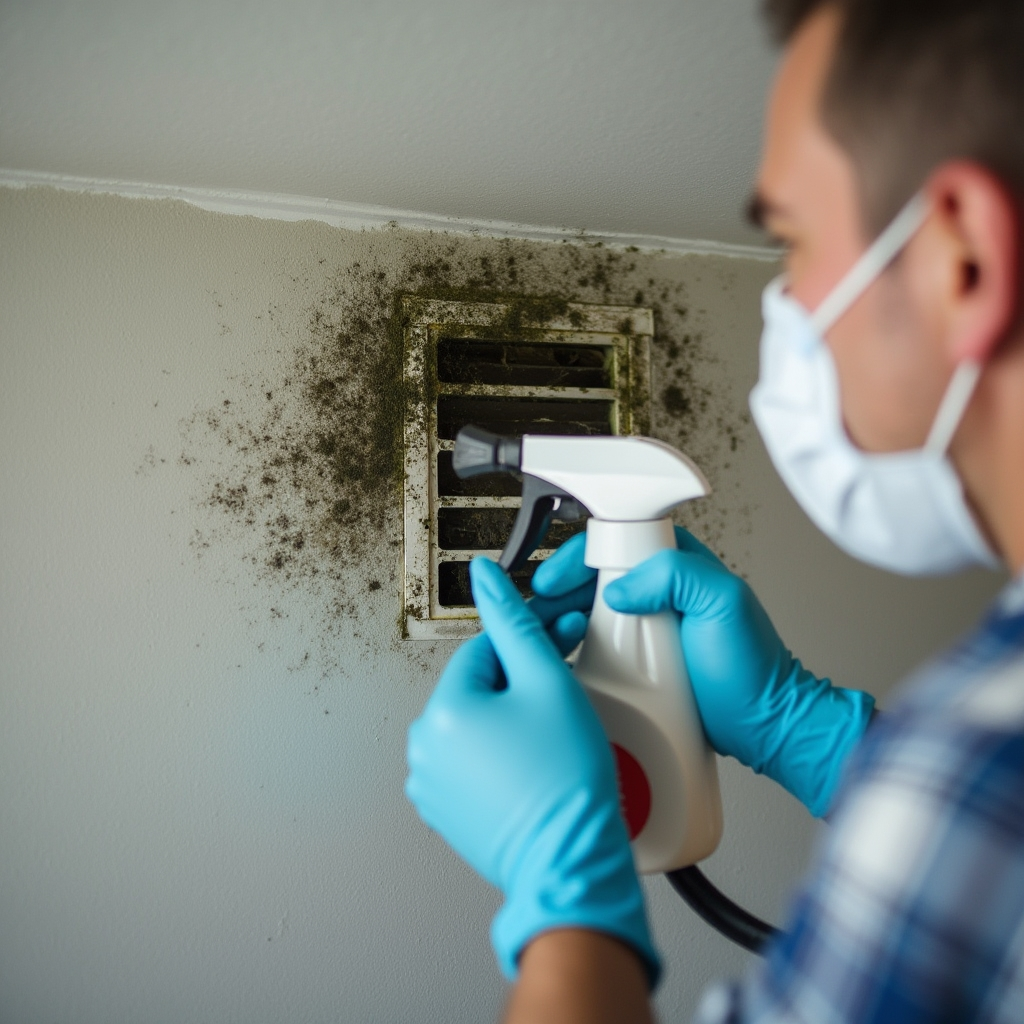What Causes Mold on Air Vents and How to Treat It Safely
Imagine turning on your air conditioning, expecting fresh, clean air—only to notice a musty smell and black spots around your air vents. That’s a sign of mold, a silent invader affecting your indoor air quality and health.
Breathing in mold spores can trigger allergies, respiratory issues, and long-term health risks for you and your loved ones. If left untreated, mold on air vents can spread throughout your home, compromising your HVAC system and making it harder to maintain clean, breathable air.
This guide will cover what causes mold on air vents, how to treat it safely, and what steps you can take to prevent it from returning.

What Causes Mold on Air Vents?
Mold on air vents is a common issue that can negatively impact indoor air quality and HVAC performance. Since mold thrives in dark, damp environments, air vents and ductwork create ideal conditions for its growth. Understanding the factors that contribute to mold on air vents can help homeowners take proactive measures to prevent it.
Understanding Mold Growth in HVAC Systems
HVAC systems circulate air throughout the home, but they can also become breeding grounds for mold when the right conditions are present. Several key factors contribute to mold development inside air vents:
Excess Moisture
Mold requires moisture to grow, and condensation inside air ducts provides the perfect environment. When warm, humid air meets cool vent surfaces, moisture forms, allowing mold spores to settle and multiply. High indoor humidity levels and poor insulation around ductwork can make this problem worse.
Poor Ventilation
Stagnant air inside HVAC ducts allows mold spores to settle and colonize. Homes with inadequate airflow, blocked vents, or irregular HVAC use often experience mold buildup in air vents. Proper ventilation helps prevent the conditions that allow mold to thrive.
Dust and Debris
Dust, pet dander, and other organic matter inside air ducts serve as a food source for mold. Over time, as these particles accumulate, mold spores find an ideal environment to grow and spread. Regular duct cleaning and air filter replacement can help minimize this risk.
Leaky Ductwork
Cracks, gaps, or loose connections in duct systems can introduce excess moisture and contaminants, accelerating mold development. Leaky ducts not only contribute to mold growth but also reduce HVAC efficiency, increasing energy costs. Sealing leaks and ensuring proper insulation can help mitigate the risk of mold in air vents.
Mold growth in air vents is more than just a nuisance—it can affect respiratory health, create unpleasant odors, and reduce HVAC system efficiency. Addressing these underlying causes is crucial for preventing mold on air vents and maintaining a cleaner, healthier home environment.
Signs You Have Mold on Your Air Vents
Visual Signs of Mold
Mold is often visible near vent openings and duct interiors. Common indicators include:
-
Black, green, or white spots around air vents.
-
Discoloration on vent covers or surrounding walls.
Unpleasant Odors
One of the first clues of mold is a persistent musty smell. This odor intensifies when your HVAC system is running and may be strongest near affected vents.
Health Symptoms from Mold Exposure
Exposure to mold spores can trigger various health problems, including:
-
Frequent coughing, sneezing, and sinus congestion.
-
Worsening asthma or allergy symptoms.
-
Chronic headaches, dizziness, or unexplained fatigue.
HVAC Performance Issues
Mold buildup can affect how efficiently your HVAC system operates:
-
Reduced airflow due to blockages in the ductwork.
-
Uneven temperatures in different rooms.
-
Increased energy bills as your HVAC system struggles to compensate.
How to Treat Mold on Air Vents Safely
Mold on air vents can quickly spread through your HVAC system, contaminating indoor air and causing health issues. Proper removal requires a safe and thorough approach to prevent spores from becoming airborne and recontaminating your home. Follow these steps to effectively treat mold on air vents while minimizing health risks.
Step 1: Turn Off Your HVAC System
Before cleaning mold, turn off your HVAC system to prevent spores from spreading through your home’s ventilation system. Running the system while cleaning can disperse mold particles, making the problem worse and potentially contaminating other areas.
Step 2: Wear Protective Gear
Mold spores can cause allergic reactions, respiratory problems, and skin irritation. To protect yourself during the cleaning process:
- Wear gloves to prevent direct skin contact.
- Use an N95 mask or respirator to avoid inhaling airborne mold spores.
- Wear safety goggles to protect your eyes from spores and cleaning solutions.
Step 3: Clean Mold from Air Vents
Removing visible mold from air vents is crucial for stopping further contamination. Follow these steps for effective cleaning:
- Remove vent covers and wash them with warm water and mild detergent.
- Scrub visible mold from vents using a soft brush or microfiber cloth.
- Rinse and dry thoroughly before reattaching to prevent moisture buildup.
Step 4: Apply an Antifungal Solution
Mold-killing solutions help eliminate spores and prevent regrowth. Effective options include:
- A mixture of white vinegar and water (one part vinegar to one part water).
- A solution of hydrogen peroxide and water (three percent hydrogen peroxide works well).
- Commercial mold removers designed for HVAC components.
Spray the antifungal solution onto the affected area and let it sit for 10–15 minutes before wiping clean with a dry cloth.
Step 5: Replace or Clean Air Filters
Dirty air filters trap mold spores and can contribute to future mold growth inside the HVAC system. To maintain clean airflow:
- Replace old filters with high-quality HEPA filters, which are designed to capture mold spores.
- If using a reusable filter, clean it according to the manufacturer’s instructions to ensure effective filtration.
Step 6: Inspect and Clean Ducts
If mold is present inside the ductwork, surface cleaning of air vents will not be enough. Mold inside ducts requires professional cleaning to prevent recontamination.
- Look for signs of mold inside the ducts, such as musty odors or black spots near vents.
- Contact AirDuctVet Cleaning Services for a thorough duct inspection and mold removal to ensure your entire HVAC system is free from contamination.

Preventing Mold on Air Vents
Mold on air vents is a common issue that can significantly affect indoor air quality, leading to musty odors, respiratory problems, and HVAC inefficiency. Since air vents circulate air throughout your home, any mold growth in these areas can quickly spread spores into your living space. Preventing mold on air vents requires proactive measures such as moisture control, proper ventilation, and routine maintenance.
Control Humidity Levels
Mold thrives in damp environments, making humidity control a crucial step in preventing mold growth on air vents and inside ductwork.
- Maintain indoor humidity below 50% by using dehumidifiers, especially in high-moisture areas like basements and bathrooms.
- Fix leaks or condensation issues around windows, pipes, and HVAC components to prevent excess moisture buildup.
- Ensure proper ventilation by running exhaust fans in kitchens, bathrooms, and laundry rooms to reduce humidity levels.
- Use a hygrometer to monitor humidity and take corrective actions if levels rise above the recommended range.
Improve Airflow and Ventilation
Restricted airflow can cause moisture buildup, creating the perfect conditions for mold to grow on air vents and inside HVAC systems.
- Regularly clean and unblock air vents to ensure proper air circulation throughout your home.
- Keep furniture and curtains away from vents to prevent airflow restriction.
- Run your HVAC system regularly to keep air moving and reduce humidity buildup in the ductwork.
- Schedule professional HVAC maintenance to ensure your system is functioning efficiently and promoting good airflow.
Use Mold-Resistant Air Filters
Upgrading your air filters can help trap mold spores before they spread through your ventilation system.
- Invest in high-efficiency HEPA filters, which capture mold spores and other airborne contaminants more effectively.
- Replace air filters every 1–3 months to maintain clean air circulation and prevent mold buildup.
- Consider using antimicrobial-treated filters, which are designed to inhibit mold and bacterial growth inside your HVAC system.
Schedule Regular Duct Cleaning
Mold on air vents often originates from inside the ductwork, where dust and moisture create the perfect environment for mold spores to thrive.
- Dust and debris in air ducts act as a breeding ground for mold, making professional cleaning essential.
- Professional air duct cleaning removes mold spores and prevents future growth by sanitizing the system.
- Experts can apply antimicrobial treatments inside the ductwork to inhibit future mold development.
- Regular duct inspections help detect early signs of mold, preventing costly remediation efforts.
By following these preventative steps, you can reduce the risk of mold on air vents, improve indoor air quality, and extend the lifespan of your HVAC system. If you suspect mold growth in your vents, scheduling a professional inspection and cleaning is the best way to ensure a safe and healthy home environment.
FAQ About Mold on Air Vents
Is mold on air vents dangerous?
Yes, exposure to mold spores can cause allergies, respiratory issues, and long-term health problems.
Can I clean mold on air vents myself?
Small amounts of mold can be cleaned with household solutions, but extensive mold growth requires professional treatment.
What’s the best way to prevent mold on air vents?
Control indoor humidity, clean air filters regularly, and schedule routine duct maintenance.
When should I call a professional for mold removal?
If mold returns after cleaning, if it spreads inside ducts, or if you experience persistent health issues.

Why Choose AirDuctVet Cleaning Services for Mold Removal?
Expert Mold Treatment: Our specialists use advanced techniques to safely remove mold from air vents and ducts.
Improved Indoor Air Quality: We eliminate contaminants, allergens, and mold spores to keep your home’s air fresh.
Reliable & Affordable: Our professional services ensure long-lasting mold prevention at competitive prices.
Conclusion
Mold on air vents is more than just an eyesore—it’s a risk to your home’s air quality and your family’s health. By identifying mold early and treating it properly, you can ensure clean, fresh air throughout your home.
Take Action Today Don’t let mold compromise your indoor air quality. Contact AirDuctVet Cleaning Services for expert mold removal and air duct cleaning. Breathe easier with our trusted professional services!
